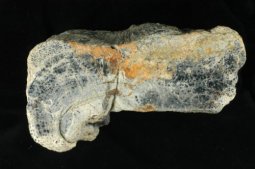
V. Miscellaneous |
I. The
fossil II. A fungus? (Hueber) III. An alga? (Schweitzer) IV. A lichen? (Selosse) VI. Literature and credits |
- Some fossils of Prototaxites show shrinking cracks. Click on
the lef hand photo. This phenomenon has not yet been clarified.
- Unfortunately the silicified Prototaxites in Europe are badly preserved.
In most cases the quartz crystals have destroyed the inner structure. Sometimes
even a pattern of pseudo cells can be observed, in which the dark organic
remains form the separation between the quartz crystals (click on the right
hand photo). At most some vague lines indicate where the skeletal hyphae
have been. In Prototaxites from the Taunus quartzit sometimes skeletal
hyphae are visible on the transverse section.
- Research has recently given indications that the chemical composition
of Prototaxites points in the direction of a fungus (Boyce et al.,
2003, 2007). This is not necessarily in contradiction with the lichen hypothesis
because a lichen has also a fungus component.
- According to Boyce the trunk could reach the big size because it was simply
growing further and further without being attacked by quadrupeds, who didn't
appear until the Middle-Devonian. Only storms could damage the
trunks, but apparently they were solidly attached to the
underground.
- In Australia a piece of Prototaxites has been found with
embedded remains of vascular plants, which are full of hyphae. This could
be interpreted as a part of the mycelium of Prototaxites (Hueber,
2001).
- There are some reports of (indications of) branching. E.g. Altmeyer
(1973) described structures resembling scars of side branches.
- Heidtke (2006) reports indications for branching inside the concentric
structures in a transverse section of Prototaxites from a quarry near
Birkenfeld in the Hunsrück (Germany).
- A specimen of Prototaxites from the River IJssel
in the Netherlands shows a structure of skeleton hyphae on the surface
and also concentrical arranged more or less circular spots. Similar specimens
are known from the Isle of Spitsbergen. The occurrence of rows of spots has
not yet been elucidated. Click on the photos for more details.
 Prototaxites from Spitsbergen with rows of spots |